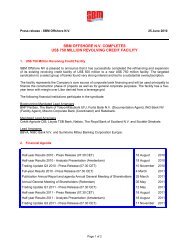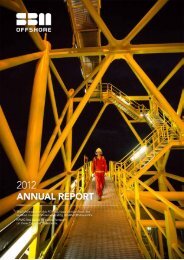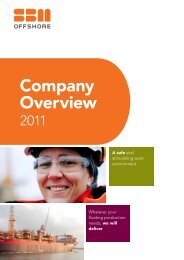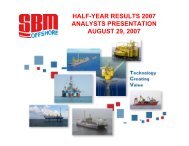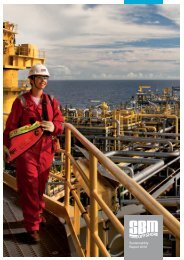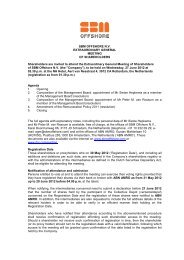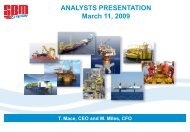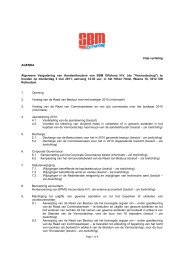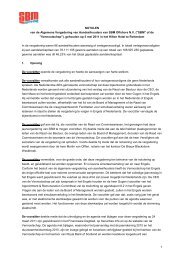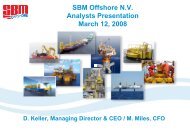Annual Report 2010 - SBM Offshore
Annual Report 2010 - SBM Offshore
Annual Report 2010 - SBM Offshore
Create successful ePaper yourself
Turn your PDF publications into a flip-book with our unique Google optimized e-Paper software.
<strong>Report</strong> of the Board of Management<br />
that these technologies will play an increasing role in<br />
the development of the offshore oil and gas industry,<br />
and thus in the growth of the Company.<br />
<strong>Offshore</strong> Production of LNG<br />
The FLNG presents a cost-effective means to develop<br />
stranded gas reserves, and may allow the industry to<br />
reassess the way it values gas assets. The Company<br />
is committed to securing, together with partners, a<br />
contract for the supply of an FLNG vessel at the earliest<br />
opportunity.<br />
The FLNG is typically a fully stand-alone system for<br />
gas field development, with extensive pre-treatment<br />
facilities able to receive raw gases and well fluids,<br />
similar to the majority of oil-producing FPSOs operating<br />
today. The hull, a major critical component of the<br />
FLNG, will be fitted with tanks for storage of the LNG<br />
and Liquefied Petroleum Gas (LPG). The hull further<br />
supports all required topsides facilities and utility systems<br />
required for the processing of the incoming field<br />
gas stream. The FLNG will therefore be able to treat,<br />
fractionate, liquefy, store and then export LNG, associated<br />
LPGs and condensate by-products.<br />
The Company’s development efforts have been deliberately<br />
concentrated on an FLNG with ‘medium-size’<br />
LNG production capacities, typically around 2.5 million<br />
tonnes per year (mtpa) of LNG, as this presents<br />
the best balance in terms of technical and commercial<br />
viability. The current list of FLNG project opportunities<br />
predominantly require LNG production capacities in<br />
the range 2-3 mtpa, for the development of a gas field<br />
in excess of 1.5 trillion cubic feet (tcf) of recoverable<br />
gas reserves.<br />
The Company finalised the basic design of its generic<br />
medium-size FLNG facility in 2008. With partners, <strong>SBM</strong><br />
<strong>Offshore</strong> has developed a detailed project execution<br />
plan, and shipyard building slots for the hull have been<br />
secured. The development effort resulted in a comprehensive<br />
‘generic FLNG design toolbox’ in 2009. The<br />
established toolbox approach allows easy and rapid<br />
adaptation of the FLNG design to the specific requirements<br />
of offshore gas projects, whilst maintaining<br />
control of the safety aspects, execution risks and cost<br />
for each particular case.<br />
70 <strong>SBM</strong> <strong>Offshore</strong> – <strong>Annual</strong> <strong>Report</strong> <strong>2010</strong><br />
It is envisaged that this generic approach will allow a<br />
series of FLNGs to be developed in a relatively short<br />
time, helping to reduce schedules and costs, and<br />
hence also improve the economics of subsequent projects.<br />
Working in partnership with vessel manufacturers<br />
and cryogenic technology companies, extensive marketing<br />
efforts continued throughout <strong>2010</strong> to all major<br />
potential clients. As a consequence, the Company, in<br />
consortium with partners, was awarded a FEED study<br />
by Petrobras for an FLNG, which will operate as a gasgathering<br />
station for several oil FPSOs in the Santos<br />
Basin pre-salt fields offshore Brazil.<br />
<strong>Offshore</strong> LNG Offloading<br />
Currently, open sea ship-to-ship LNG transfer is only<br />
possible in benign environmental conditions in a sideby-side<br />
configuration. Offloading operations from LNG<br />
FPSOs or loading of FSRUs outside of these areas<br />
favours the use of tankers mooring in tandem to the<br />
FPSO, as commonly used for the offloading of oil from<br />
FPSOs to oil tankers, as it improves both the safety and<br />
the up-time availability. In several key target areas for<br />
FLNG projects around the world, tandem offloading is<br />
mandatory thus requiring safe, efficient LNG transfer to<br />
an LNG tanker.<br />
The Company therefore initiated a programme to<br />
develop a cryogenic hose to be used in a floating or<br />
submerged configuration for LNG transfer. The hose<br />
design is based on a patented hose-in-hose system,<br />
which combines two proven hose technologies.<br />
The design is comprised of a standard outer marine<br />
hose with a proven inner-composite LNG hose. The<br />
cavity between the hoses is filled with insulating materials<br />
with thermal and elastic properties over the full<br />
range of ambient to cryogenic temperatures. Having<br />
proven the feasibility of the concept with an 8-inch<br />
internal diameter (ID) hose, an 18-inch ID hose has now<br />
completed a full qualification and certification program.<br />
Interest in the COOL TM Hose remains strong amongst<br />
all the major potential clients.<br />
<strong>Offshore</strong> LNG Regasification<br />
The Company maintains in its portfolio a range of<br />
generic FSRU concepts, developed for a wide range of<br />
LNG storage and regasification requirements, to meet<br />
the higher capacity range of gas-supply contracts.



